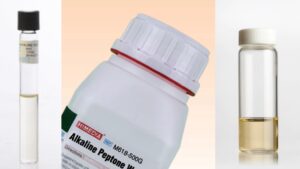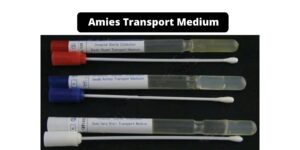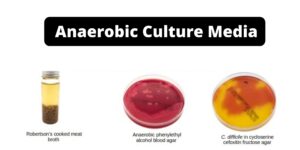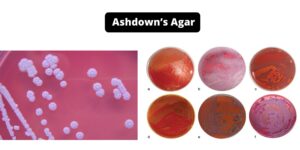What is Anaerobic Blood Agar?
- Anaerobic Blood Agar is a solid medium specifically designed for the qualitative isolation and cultivation of anaerobic microorganisms, including both fastidious and slow-growing strains. It was developed by V.R. Dowell and T.M. Hawkins at the Centers for Disease Control and Prevention in Atlanta, Georgia.
- This agar medium provides an environment conducive to the growth of anaerobic organisms, which require an oxygen-free atmosphere for their survival and propagation. Anaerobic Blood Agar supports the optimal growth and typical pigmentation of various anaerobic bacteria, including those of significant clinical importance.
- The formulation of Anaerobic Blood Agar typically involves the addition of sheep or horse blood to a base agar, providing essential nutrients and factors required for the growth of anaerobic microorganisms. The blood components serve as a source of nutrients, enhance the recovery of certain anaerobes, and may exhibit characteristic hemolytic reactions.
- The medium’s ability to support the growth of fastidious and slow-growing anaerobes makes it valuable for primary isolation and cultivation in clinical microbiology laboratories. It allows for the detection, identification, and characterization of anaerobic bacteria, which play a crucial role in various infectious processes and clinical conditions.
- Overall, Anaerobic Blood Agar is a reliable and widely used medium that provides optimal conditions for the isolation and cultivation of anaerobic organisms. Its formulation and utilization enable the successful recovery and identification of anaerobic bacteria in clinical and research settings.
Composition of Anaerobic Blood Agar
| Ingredients | Gms/liter |
| Casein enzymic hydrolysate | 15.000 |
| Papaic digest of soybean meal | 5.000 |
| Yeast extract | 5.000 |
| Sodium chloride | 5.000 |
| L-Cysteine | 0.500 |
| Hemin | 0.005 |
| Agar | 13.50 |
Final pH: 7.4±0.2
Principle of Anaerobic Blood Agar
The principle of Anaerobic Blood Agar is based on the following characteristics and components:
- Nonselective Medium: Anaerobic Blood Agar serves as a nutritious and nonselective medium, allowing the cultivation of a wide range of microorganisms, including fastidious anaerobes, aerobic bacteria, and microaerophilic organisms.
- Peptones: The inclusion of peptones in the agar base provides nitrogenous substances and essential amino acids necessary for the growth of anaerobic bacteria. These nutrients support the overall growth and metabolism of the microorganisms.
- Yeast Extract: Yeast extract serves as a growth enhancer in Anaerobic Blood Agar. It provides B-complex vitamins, which are essential for the growth and proliferation of microorganisms, including anaerobes.
- Hemin, Vitamin K, and Sheep Blood: Anaerobic Blood Agar contains hemin, vitamin K, and sheep blood. These components play important roles in stimulating the growth of specific anaerobic bacteria. Hemin and vitamin K support the growth of anaerobes such as Bacteroides species, while sheep blood provides additional nutrients and aids in the differentiation of hemolytic organisms.
- Sodium Chloride: Sodium chloride is added to Anaerobic Blood Agar as a source of essential electrolytes. It helps maintain the osmotic equilibrium of the medium, providing optimal conditions for microbial growth.
The combination of these components in Anaerobic Blood Agar creates a suitable environment for the cultivation and differentiation of various microorganisms, including fastidious anaerobes. The peptones, yeast extract, hemin, vitamin K, and sheep blood contribute to the nutritional requirements and growth stimulation of anaerobic bacteria, facilitating their growth and allowing for their isolation and identification in the laboratory setting.
Intended Use
Recommended for cultivation of anaerobic microorganisms, including very fastidious organisms from clinical specimens.
Preparation of Anaerobic Blood Agar and Method of Use
To prepare and use Anaerobic Blood Agar, follow these steps based on the provided information:
- Suspend 44.0 grams of Anaerobic Blood Agar in 1000 ml of distilled water.
- Heat the mixture to boiling to ensure complete dissolution of the medium.
- Add the rehydrated contents of 1 vial of Vitamin K1 solution to the medium.
- Sterilize the medium by autoclaving at 15 lbs pressure (121°C) for 15 minutes.
- Allow the medium to cool to 45-50°C.
- Aseptically add 5% volume/volume (v/v) of sterile defibrinated sheep blood to the cooled agar medium.
- Mix the medium thoroughly to ensure even distribution of the blood.
- Pour the prepared medium into sterile Petri plates.
- Before use, place the plates in an anaerobic environment at room temperature for a minimum of 24 hours to reduce them.
- Inoculate specimens for anaerobic culture on both selective and non-selective media as soon as possible after receiving them in the laboratory. Streak plates to isolate individual colonies.
- Incubate the inoculated plates anaerobically at 33-37°C for 48-72 hours.
- Confirm anaerobic growth by subculturing the isolated colonies onto an anaerobic blood agar plate.
By following these preparation and usage steps, you can create a suitable environment for the isolation and cultivation of anaerobic microorganisms using Anaerobic Blood Agar. The addition of sheep blood and incubation under anaerobic conditions allow for the growth of anaerobes, aiding in their identification and further analysis.
Result Interpretation of Anaerobic Blood Agar
When interpreting the results of Anaerobic Blood Agar, consider the following information:
- Colonial Morphology: Note the colonial morphology of different colony types observed on the agar. Pay attention to factors such as size, shape, texture, and elevation. Additionally, observe for any pitting or pigment production.
- Fluorescence: Examine the plates under ultraviolet (UV) light to determine the presence of fluorescence. Coccobacilliary organisms that fluoresce brick-red or produce black colonies are typically classified within the pigmented Prevotella-Porphyromonas spp. group.
- Additional Tests: Perform further tests to presumptively identify the anaerobic organisms present. These tests may include gram staining, catalase testing, spot indole testing, and special-potency antibiotic disk susceptibility testing.
- Incubation Period: Keep in mind that some slow-growing anaerobic bacteria may require up to 7 days of incubation to produce noticeable colonies. Be patient when awaiting the growth and development of certain organisms.
- Veillonella Species: Some Veillonella species may also exhibit red fluorescence under UV light. This characteristic can aid in their identification.
- Pigmented Prevotella and Porphyromonas: Different species of pigmented Prevotella and Porphyromonas vary in the degree and rapidity of pigment production. It is important to note that the absence of pigmentation after the incubation period does not rule out their presence. Further biochemical tests are necessary to establish their identity.
Overall, the presence of brick-red fluorescence is a reliable indicator for the presumptive identification of pigmented species within the Porphyromonas and Prevotella groups. However, for accurate identification and confirmation of anaerobic organisms, additional biochemical tests and analyses are required.
| Organisms | Growth |
| Bacteroides fragilis | Luxuriant Growth |
| Bacteroides melaninogenicus | Luxuriant Growth |
| Peptostreptococcus anaerobius | Luxuriant Growth |
| Clostridium perfringens | Growth, double zone β-hemolysis |
| Fusobacterium nucleatum | Growth |
| Prevotella melaninogenica | Growth; pigment (tan to brown) |
| Escherichia coli | Growth |
| Staphylococcus aureus | Growth |
Quality Control
To ensure the quality of Anaerobic Blood Agar, the following organisms are used to determine the growth performance of the completed medium:
- Prevotella melaninogenica (ATCC 25845):
- Expected Result: Growth and red fluorescence
- This organism should exhibit visible growth on the agar, along with a distinctive red fluorescence when observed under ultraviolet light. The presence of these characteristics indicates that the medium is supportive of the growth and pigmentation of Prevotella melaninogenica.
- Bacteroides fragilis (ATCC 25285):
- Expected Result: Growth and no fluorescence
- Bacteroides fragilis should demonstrate visible growth on the agar, but without any observable fluorescence under ultraviolet light. This result confirms that the medium is conducive to the growth of Bacteroides fragilis without inducing fluorescence.
| Organism Tested | ATCC # | Results | Time | Special Reaction |
| Bacteroides fragilis * | 25285 | Growth | 24 hrs | |
| Prevotella melaninogenica * | 25845 | Growth | 24-48 hrs | Pigmentt (tan to brown) |
| Fusobacterium necrophorum | 25286 | Growth | 24 hrs | |
| Fusobacterium nucleatum * | 25586 | Growth | 24 hrs | |
| Clostridium perfringens * | 13124 | Growth | 24 hrs | Double zone β-hemolysis |
| Peptostreptococcus anaerobius * | 27337 | Growth | 24 hrs | |
| Staphylococcus aureus or Enterococcus faecalis | 25923 29212 | GrowthGrowth | 24 hrs24 hrs | |
| Escherichia coli | 25922 | Growth | 24 hrs | |
| Proteus mirabilis | 12453 | Growth | 24 hrs | |
| Clostridium difficile or Propionibacterium acnes | 9689 6919 | GrowthGrowth | 24 hrs24-48 hrs |
Uses of Anaerobic Blood Agar
Anaerobic Blood Agar has several uses in microbiology, as outlined below:
- Cultivation of Anaerobic Microorganisms: Anaerobic Blood Agar Base is specifically recommended for the cultivation of anaerobic microorganisms. It provides a suitable environment for the growth and propagation of these organisms, including very fastidious ones, which can be challenging to cultivate using other media. This makes Anaerobic Blood Agar an essential tool in clinical microbiology for the isolation and identification of anaerobic bacteria from various clinical specimens.
- Pigment Formation in Bacteroides melaninogenicus: Anaerobic Blood Agar promotes the formation of typical pigmentation in Bacteroides melaninogenicus. The presence of blood added to the medium base supports the growth and pigment production by these organisms. The observation of pigmentation can aid in the identification and differentiation of specific anaerobic bacteria.
- Double Hemolytic Reaction in Clostridium perfringens: The addition of blood to Anaerobic Blood Agar base allows for the detection of a double hemolytic reaction in Clostridium perfringens. This characteristic reaction helps in the identification and differentiation of this anaerobic pathogen.
- Pigmented Prevotella and Porphyromonas: Anaerobic Blood Agar supports the typical pigment production by pigmented species of Prevotella and Porphyromonas. The medium provides the necessary nutrients and conditions for these organisms to exhibit their characteristic pigmentation, aiding in their identification and differentiation.
Limitations of Anaerobic Blood Agar
Anaerobic Blood Agar, despite its usefulness, has certain limitations that should be taken into consideration:
- Sensitivity to Oxygen: Anaerobic Blood Agar requires special handling to maintain its oxygen-free conditions. The media must be prepared, dispensed, and packaged under oxygen-free conditions to prevent the formation of oxidized products before use. Exposure to oxygen can affect the growth and viability of anaerobic microorganisms and compromise the results.
- Incomplete Identification: While Anaerobic Blood Agar supports the growth and cultivation of anaerobic microorganisms, it does not provide complete information for the identification of bacterial isolates. Additional test procedures and the use of different media are necessary to obtain a comprehensive identification of the organisms. This may include biochemical, immunological, molecular, or mass spectrometry testing on colonies from pure cultures.
- Limited Selectivity: Although Anaerobic Blood Agar can support the growth of a wide range of anaerobic microorganisms, it may not be sufficient for the growth of all species present in a clinical specimen. To ensure the growth of all potential species, it is recommended to use selective media such as Anaerobic Brucella Laked Blood Agar with Kanamycin and Vancomycin and/or Anaerobic Brucella Blood Agar with Phenylethyl Alcohol in addition to Anaerobic Blood Agar.
FAQ
What is Anaerobic Blood Agar used for?
Anaerobic Blood Agar is used for the cultivation and isolation of anaerobic microorganisms, particularly fastidious strains, from clinical specimens.
How does Anaerobic Blood Agar support the growth of anaerobic organisms?
Anaerobic Blood Agar provides a nutritious and non-selective medium that allows the growth of anaerobic bacteria, including fastidious ones. It contains peptones, yeast extract, hemin, vitamin K, and sheep blood, which provide essential nutrients and stimulate the growth of anaerobes.
What is the purpose of adding blood to Anaerobic Blood Agar?
The addition of blood to Anaerobic Blood Agar helps in the differentiation of hemolytic organisms and supports the growth of certain anaerobic bacteria that require the presence of blood for optimal growth.
Can Anaerobic Blood Agar be used for the isolation of aerobic microorganisms?
Yes, Anaerobic Blood Agar can also support the growth of aerobic and microaerophilic microorganisms. However, it is primarily designed for the cultivation of anaerobes.
What is the recommended incubation temperature for Anaerobic Blood Agar?
Anaerobic Blood Agar should be incubated at 33-37°C for 48-72 hours under anaerobic conditions to allow the growth of anaerobic microorganisms.
Can slow-growing anaerobic bacteria be detected on Anaerobic Blood Agar?
Yes, some slow-growing anaerobic bacteria may require up to 7 days of incubation to produce noticeable colonies on Anaerobic Blood Agar.
Is Anaerobic Blood Agar suitable for complete identification of bacterial isolates?
No, Anaerobic Blood Agar alone does not provide complete information for the identification of bacterial isolates. Additional test procedures and media are required for complete identification.
What are the limitations of Anaerobic Blood Agar?
The limitations of Anaerobic Blood Agar include the need for careful handling under oxygen-free conditions, incomplete identification without additional tests, and the recommendation to use selective media alongside it to ensure the growth of all species present.
How should Anaerobic Blood Agar plates be stored before use?
Anaerobic Blood Agar plates should be stored in an anaerobic environment at room temperature for a minimum of 24 hours prior to use to allow for reduction.
What can be observed after incubation on Anaerobic Blood Agar?
After incubation, characteristic colony morphology, pigmentation, and fluorescence patterns can be observed on Anaerobic Blood Agar, aiding in the presumptive identification of certain anaerobic organisms.
References
- https://www.dalynn.com/dyn/ck_assets/files/tech/PA55.pdf
- https://assets.thermofisher.com/TFS-Assets/LSG/manuals/IFU1040.pdf
- https://assets.fishersci.com/TFS-Assets/LSG/manuals/IFU1060.pdf
- https://anaerobesystems.com/products/plated-media/anaerobe-blood-agar-cdc/
- https://www.fishersci.com/shop/products/remel-anaerobic-blood-agar/R01036
- https://hardydiagnostics.com/a62
- https://www.carolina.com/prepared-biological-media/anaerobe-blood-agar-prepared-media-plates-100-x-15-mm-pack-10/821192.pr
- https://www.himedialabs.com/in/mp975a-anaerobic-blood-agar-plate.html



